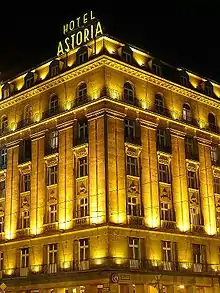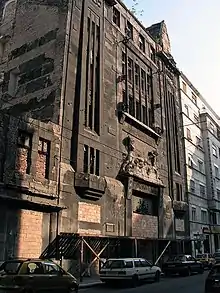Emil Ágoston
Emil Ágoston (originally Adler) (born Zlaté Moravce, German: Goldmorawitz, Hungarian: Aranyosmarót; December 7, 1876 – June 15, 1921, in Berlin), was a notable Hungarian architect.
Life and career

Hotel Astoria, Budapest, 1913
Ágoston graduated at the Budapest Technical University in 1899 and completed further studies in Italy. He also spent time living in Berlin and Paris. His most productive period, as a sought after designer of apartment buildings in Budapest, was between 1906 and 1911. His style was influenced by the Romantic style, particularly its north German variants. After 1919 he established a partnership with his brother, Géza.[1] Together they built the Roman baths in Budapest and a similar project in the Netherlands.
Works

Hungaria baths, Budapest, 1906-07
- Budapest
- Hungaria baths (VII. Dohány utca 44.) now Hotel Zara, 1906-07[2]
- Unger house (V. Irányi u. 10.), 1906–07
- Csasznek house (I. Attila út 47.), 1906–07
- Krayer house (XIII. Csanády u. 2.), 1909–10
- Apartment building (V. Dorottya u. 9.), 1909–10
- Gyenes villa (II. Nyúl u. 6.), 1909–10
- Apartment building (VII. Wesselényi u. 32.). A 5-storey corner building which shows the north German influences but little has remained of its original facade decorations (a protected building since 1994)., 1909–10
- Former Magyar Bank (V. Kristóf tér), 1913
- Bank building (V. Bajcsy-Zsilinszky u. 36), 1913
- Astoria Hotel (Múzeum körút), with elements of the neoclassical style., 1913
- Abroad
- Trieste synagogue (1908)
- Frankfurt synagogue (2nd prize in competition)
- Pervát — Jékey Albert Castle (1907)
References
- Építészforum: "Decemberi évfordulók", 8 December 2011, (in Hungarian)
- David A. Hill: "Cycles in the Life of Budapest Secession Buildings - A Plea", in Hungarian Review, Vol. III, Nr. 2, 7 June 2011
This article is issued from Wikipedia. The text is licensed under Creative Commons - Attribution - Sharealike. Additional terms may apply for the media files.